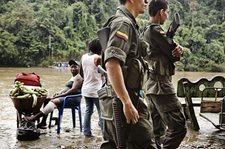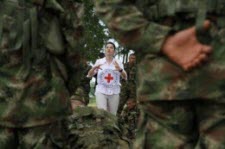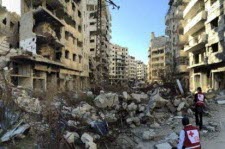What is International Humanitarian Law?
 What is International Humanitarian Law? International Humanitarian Law is a set of rules that seek to limit the effects of armed conflict. Learn more > |
 Who is protected? International Humanitarian Law protects victims of armed conflicts, including civilians and those no longer taking part in hostilities Learn more > |
 What are the sources of IHL? The Geneva Conventions of 1949 and its Additional Protocols are some of the main sources of IHL. Learn more > |
 How does IHL restrict weapons and tactics? International Humanitarian Law prohibits and regulates the use of certain weapons and methods of warfare. Learn more > |
What is International Humanitarian Law?
International Humanitarian Law, also known as the law of armed conflict, is the body of wartime rules that protect people who are not or are no longer participating in hostilities. IHL also restricts the means and methods of war. Its central purpose is to limit and prevent human suffering in times of armed conflict. International Humanitarian Law regulates the treatment of the wounded and prohibits attacks against civilians and the use of certain weapons. It also ensures the protection of non-combatants; Red Cross/Red Crescent and medical personnel; and prisoners of war.
When does it apply?
International Humanitarian Law applies only during times of armed conflict. It does not cover internal tensions or disturbances such as isolated acts of violence. The laws apply only once a conflict has begun, and then equally to all sides, regardless of who started the fighting.
International Humanitarian Law distinguishes between international and non-international armed conflicts:
- International armed conflict: International armed conflicts usually involve at least two countries. They are subject to a wide range of rules, including those set out in the four Geneva Conventions and Additional Protocol I.
- Non-international armed conflict: Non-international armed conflicts usually take place within the territory of a single country, between either state armed forces and organized armed groups, or between organized armed groups fighting each other. A more limited range of rules applies to these non-international armed conflicts, set out in Common Article 3 of the four Geneva Conventions, as well as in Additional Protocol II (when applicable).
Canada’s obligations under IHL
Governments, including Canada, must ensure respect for International Humanitarian Law. States are obligated to teach it to their armed forces and to the general public. States must enact laws to punish serious violations of the Geneva Conventions and Additional Protocols. These serious violations can amount to war crimes. Governments must also pass laws protecting the Red Cross, Red Crescent, and Red Crystal emblems.
Canada has signed and ratified the major international conventions on humanitarian law. People who commit war crimes or grave breaches of International Humanitarian Law can be tried and punished under Canadian criminal law. The Government of Canada instructs the armed forces and civilians on International Humanitarian Law, so that the entire population can understand its principles.
 The Canadian Red Cross supports this work by educating the armed forces, lawmakers, politicians, youth, and the public about international humanitarian law. The more people know about International Humanitarian Law and the more they understand its impact on human life and dignity, the more likely IHL will be respected.
The Canadian Red Cross supports this work by educating the armed forces, lawmakers, politicians, youth, and the public about international humanitarian law. The more people know about International Humanitarian Law and the more they understand its impact on human life and dignity, the more likely IHL will be respected.
National Committee on International Humanitarian Law
States must implement the provisions of the Geneva Conventions and their Additional Protocols to their fullest extent. Governments are obligated to enact laws and regulations to punish violators, protect the Red Cross and Red Crescent emblems, and ensure the rights of protected persons.
International Humanitarian Law covers a broad range of issues, and implementing it requires coordination and support from many organizations. Some states have created i working groups to help the government implement and spread knowledge of International Humanitarian Law.
Canada established a National Committee on International Humanitarian Law in1998, and the Canadian Red Cross is a member of the Secretariat. The Committee includes five government departments:
- Royal Canadian Mounted Police (RCMP)
- Global Affairs Canada (GAC)
- Department of National Defence
- Department of Justice Canada
According to its terms of reference, the Committee exists to:
- Facilitate the implementation of Canada’s obligations under international humanitarian law, including reviewing national legislation and administrative measures;
- Consider and, where appropriate, recommend the ratification of additional instruments of international humanitarian law;
- Advise on dissemination and training of international humanitarian law within Canada, including but not limited to the armed forces, the police, civil servants, humanitarian organizations, the judiciary, schools and universities, journalists, and other target groups;
- Coordinate and stimulate government departments and other relevant organizations in strengthening and disseminating international humanitarian law;
- Examine and, where appropriate, recommend measures to promote the national implementation of international humanitarian law in other countries, drawing on the resources and expertise available in Canada;
- Develop and maintain pool of Canadians who are knowledgeable about international humanitarian law; and
- Liaise and exchange information on international humanitarian law with other national committees and with the International Committee of the Red Cross (ICRC).
What are the sources of IHL?
The Geneva Conventions
The 1949 Geneva Conventions and their Additional Protocols form the core ofInternational Humanitarian Law. The Conventions and Protocols specifically protect people who are not taking part in the hostilities, such as civilians, medical and aid workers, and those who are no longer fighting, including wounded, sick and shipwrecked soldiers, and prisoners of war.
- The First Geneva Convention protects wounded and sick soldiers on land.
- The Second Geneva Convention protects wounded, sick and shipwrecked military personnel at sea.
- The Third Geneva Convention applies to prisoners of war.
- The Fourth Geneva Convention affords protection to civilians, including in occupied territories.
- Additional Protocol I relating to the victims of International armed conflicts (1977).
- Additional Protocol II relating to the protection of victims of non-international armed conflicts (1977).
- Additional Protocol III relating to the adoption of an additional distinctive Emblem (2005).
The Red Cross has a unique position under the Geneva Conventions and their Additional Protocols. The International Committee of the Red Cross (ICRC) has been given a specific mandate to act in the event of an armed conflict, including the right to offer its impartial and neutral humanitarian services. Countries that are party to the Geneva Conventions must allow the ICRC to visit prisoners of war. The ICRC may also exchange family messages and help search for missing persons in countries affected by conflict.
National Red Cross and Red Crescent Societies, such as the Canadian Red Cross, have a special role as voluntary aid societies, auxiliary to the public authorities in the humanitarian field. National Societies carry out this role by delivering family messages and helping to provide medical aid and relief supplies when needed.
In addition to the Geneva Conventions and their Additional Protocols, other legal instruments prohibit the use of certain weapons and military tactics and protect certain categories of people and goods. These instruments include:
- the 1954 Convention for the Protection of Cultural Property in the Event of Armed Conflict, and its two protocols;
- the 1972 Biological Weapons Convention;
- the 1980 Convention on Certain Conventional Weapons, and its four protocols;
- the 1993 Chemical Weapons Convention;
- the 1997 Ottawa Convention on anti-personnel mines;
- the 2000 Optional Protocol to the Convention on the Rights of the Child, on the involvement of children in armed conflict
Canada has ratified many IHL conventions, harmonizing its domestic laws with the provisions contained in these treaties. People who commit war crimes or grave breaches of International Humanitarian Law can be tried and punished under Canadian criminal law. The Canadian Armed Forces receive training on International Humanitarian Law so that they know the rules and can follow them. The Canadian Red Cross is also active in promoting the rules of international humanitarian law in Canada to the armed forces and the public.
Customary Law
International law is made up of both treaty law and rules which develop over time because of "a general practice accepted as law". These rules are known as customary law. Customary IHL is particularly important when States have not ratified IHL treaties, as these states are still bound by customary law. Also, there is less treaty law governing non-international armed conflicts and so customary law becomes even more essential to fill in gaps in written law.
The ICRC Customary International Humanitarian Law study identified 161 rules of customary IHL that they suggest make up customary International Humanitarian Law that are binding on all parties to conflict.
Jus Cogens/Peremptory Norms
Certain customs or principle are so fundamental that we refer to them as jus cogens, or “compelling” law. These are things that are so self-evident that international law allows no exceptions whatsoever. For example, the banning of torture is jus cogens, which means torture is not allowed in any situation, regardless of the circumstance.
Soft Law
International Humanitarian Law is also influenced by so-called ‘soft law.’ Examples of soft law include advisory opinions by international courts (unless a treaty renders those opinions otherwise binding), UN General Assembly Resolutions, official declarations, statements, and guidelines adopted by international organizations. These non-binding instruments do not carry the same force as international treaties or custom. However, soft law can influence States to strengthen their domestic legislation related to the implementation of IHL and can be used to interpret obligations. Soft law has also been shown to play a part in the development of customary law. Examples of soft law instruments relevant to IHL include the adoption of UN Security Council Resolutions 1325 and 1820 focusing on women, peace and security.
Who is protected?
International Humanitarian Law protects a range of people and objects during war. IHL protects people who are not taking part in the fighting including civilians, medical and religious military personnel, and Red Cross/Red Crescent workers. IHL also protects the sick, wounded, shipwrecked, prisoners of war and people who are deprived of their liberty. IHL ensures special protections for vulnerable people, including foreign nationals in the power of a party to conflict, civilian internees, and women and children.
Civilian objects are protected under the general provisions of IHL. Civilian objects include things like shopping malls, schools, and homes. Some civilian objects are further protected through specific provisions of IHL. Objects with strengthened protection includes items such as: medical units and transport; cultural property and places of worship; the natural environment; and objects indispensable to the survival of the civilian population, like access to water.
Examples of protected persons:
Persons hors de combat
Combatants who can no longer participate in combat are considered hors de combat and are protected from attack. A person hors de combat includes anyone who is wounded, sick, or shipwrecked, in the power of an adverse power, or clearly expresses their intention to surrender.
Persons Deprived of their Liberty
The third Geneva Convention protects the rights of prisoners of war during international armed conflicts and provides details on what their treatment and conditions of detention must be. Under International Humanitarian Law, there are also protections in place for civilian internees during situations of international armed conflict and for persons deprived of their liberty in non-international armed conflicts.
Children
Children can be particularly vulnerable to the effects of armed conflict and so there are special IHL provisions that aim to protect children during war. Children are at risk of recruitment into armed groups or other forms of exploitation. IHL prohibits the recruitment and use in hostilities of children under 15 years of age. The rules of International Humanitarian Law also ensure that the special needs of children are considered including their need to receive food, shelter, and medical assistance. IHL clearly states that children who become separated from their families must be protected and steps must be taken to preserve or restore family unity.
Women
It is recognized that women face increased risks during armed conflict. These risks include sexual and gender-based violence, negative health consequences, especially during pregnancy; and additional difficulties providing for and caring for their family including elderly family members and young children. International Humanitarian Law protects against sexual violence and requires that needs of nursing and pregnant mothers are considered. Female combatants who are no longer participating in hostilities are afforded the same protections as men under International Humanitarian Law. However, women prisoners of war are afforded additional protection through the provision of separate detention quarters for female detainees.
Internally displaced persons
It is prohibited to forcibly displace civilians during international armed conflicts with exceptions for security purposes of the civilian population or due to an imperative military reason. IHL also contains rules which can heighten domestic laws which ensure that, when displacement does take place, internally displaced persons are protected and treated humanely.
How does IHL restrict weapons & tactics?
Principles of International Humanitarian Law prohibit and regulate the use of certain weapons. Specific types of weapons are banned entirely, such as anti-personnel landmines and biological and chemical weapons. Other weapons are subject to limits – such as the restrictions on the use of booby-traps.
The way weapons are used can be as important as what they do. For example, incendiary weapons, designed to spread fire or to burn, are prohibited in all circumstances against civilians. But lawful use against soldiers is possible. Some weapons may be lawful for use against buildings or enemy tanks but not if directed at combatants.
International Humanitarian Law prohibits:
- Indiscriminate weapons: Weapons must be able to be used in such a way that they discriminate between combatants and civilians. If a weapon cannot be directed at a specific military target, or if its effects cannot be limited, it is indiscriminate.
- Weapons that by nature cause unnecessary suffering or superfluous injury.
Types of Weapons
Chemical & Biological weapons: Chemical weapons include chemicals as well as the munitions used to carry them. The chemicals are toxins that kill or incapacitate people when they come into contact with them. Chemical weapons include cyanides, nerve agents and other chemicals that can incapacitate, asphyxiate, or irritate and severely blister skin.
Biological weapons are living organisms or replicating entities (such as viruses) that infect, incapacitate, or kill other living organisms (including humans, plants, and animals). They can have devastating effects on human civilization because relatively small quantities can cause an enormous number of casualties and could result in global pandemics.
Chemical and biological weapons are banned under international law. The ban on chemical weapons and biological weapons which are meant to affect humans is absolute: it does not matter whether they are lethal or not. Canada is a State Party to the Chemical Weapons Convention (1993) and the Convention on the Prohibition of Biological and Toxin Weapons (1972).
Nuclear weapons are munitions that use nuclear fission, fusion, or both, to kill, injure, and destroy. The catastrophic consequences of nuclear weapons could include mass civilian casualties, long-term threats to future generations as has been found in Japan, and continued risks to the health of affected populations and the environment even years after detonation.
Today, nuclear weapons are prohibited for signatories to the Nuclear Weapons Ban Treaty (2017). However, many states are not party to this treaty, including, among others, all states possessing nuclear weapons and Canada. Nuclear weapons are not prohibited as such under customary law. However, the use of nuclear weapons is regulated and must comply with International Humanitarian Law. In 1996, the International Court of Justice, the principal judicial arm of the United Nations, gave an Advisory Opinion about the legality of the threat or use of nuclear weapons. The Court examined treaty law, customary rules, and State practice with regard to nuclear weapons at that time and, based on their analysis, concluded unanimously that the principles and rules of International Humanitarian Law apply to the use of nuclear weapons.
Various legal instruments have been put in place to prevent and regulate the proliferation, testing, use, and disarmament of nuclear weapons. Canada is a State Party to the 1968 Non-Proliferation Treaty (NPT), which aims to restrict the production of nuclear warheads by promoting nuclear non-proliferation and disarmament. Requirements of both “non-nuclear states” and “nuclear states” are outlined within the Treaty.
In 2011, the International Red Cross and Red Crescent Movement expressed its deep concern about nuclear weapons, particularly, due to:
- the destructive power of nuclear weapons;
- the unspeakable human suffering they would cause;
- the difficulty of controlling their effects in space and time;
- the threat they pose to the environment and to future generations; and
- the risks of escalation they create.
The Red Cross and Red Crescent Movement appealed to all States to ensure that they never use nuclear weapons again, regardless of their views on the weapons’ legality, and asked for them to negotiate in good faith and with urgency and determination agreements to prohibit the use of and eventual complete elimination of nuclear weapons through legally binding international agreements.
Anti-personnel landmines: Anti-personnel mines are munitions that are designed to incapacitate, injure or kill people. Anti-personnel mines are illegal because of the Ottawa Treaty and the overwhelming evidence that they act as indiscriminate weapons once landmines they are set up, they can’t distinguish between a legitimate military target and a civilian. Anti-personnel mines are also dangerous because they can lay dormant for a long time—even decades after an armed conflict ends.
During the 1990s, the International Committee of the Red Cross and National Societies, including the Canadian Red Cross, joined the International Campaign to Ban Landmines in encouraging states to prohibit the use of anti-personnel landmines. The Canadian government backed the campaign and galvanized support for the signing of the 1997 Ottawa Treaty. The terms of the treaty establish a comprehensive ban on anti-personnel mines and prohibit the development, production, stockpiling and transfer, as well as the destruction and clearance of existing stockpiles and mined areas.
Cluster munitions: Cluster munitions are explosive weapons which consist of a shell containing submunitions, or small explosives. Cluster munitions are either air-dropped or launched from the ground, opening mid-air and discharging the small explosives. Cluster munitions scatter throughout large areas, and evidence has shown that they often end up outside of the original military target which puts civilians at risk. Some submunitions do not explode immediately after discharge or upon hitting the ground. They can lay dormant and continue to pose a risk of detonation which can kill and injure civilians. Due to their long-lasting and indiscriminate effects, cluster munitions are banned for signatories to the 2008 Convention on Cluster Munitions.
The Convention on Cluster Munitions, prohibiting the use, production, stockpiling, and transfer of cluster munitions, was adopted in 2008. Canada ratified the Convention on Cluster Munitions in 2015 and introduced domestic legislation to implement the Convention into Canadian law.
Conventional Weapons: The term conventional weapons refers to weapons that use kinetic, incendiary, or explosive energy to kill, injure, or destroy, and excludes weapons of mass destruction. Conventional weapons include tanks, combat helicopters, artillery, small arms, ammunition, mines, and cluster munitions. Certain conventional weapons are banned under IHL due to their indiscriminate effects on civilians or their causing unnecessary suffering or superfluous injury to combatants. The 1980 Convention on Certain Conventional Weapons is one of the main international legal instruments regulating conventional weapons. The Convention prohibits or restricts certain types of conventional weapons. The Convention provides general terms while restrictions on specific weapons are detailed in the annexed Protocols. The Protocols are as follows:
- Protocol I on Non-Detectable Fragments (1980)
- Protocol II on Prohibitions or Restrictions on the Use of Mines, Booby Traps and Other Devices (1980)
- Protocol III on Prohibitions or Restrictions on the Use of Incendiary Weapons (1980)
- Protocol IV on Blinding Laser Weapons (1995)
- Protocol V on Explosive Remnants of War (2003)
Canada is party to the Convention on Certain Conventional Weapons.
Weapons specifically banned in treaties
|
Weapon |
Treaty |
|
Explosive projectiles weighing less than 400 grams |
Declaration of Saint Petersburg (1868) |
|
Bullets that expand or flatten in the human body |
Hague Declaration (1899) |
|
Poison and poisoned weapons |
Hague Regulations (1907) |
|
Chemical weapons |
Geneva Protocol (1925) |
|
Biological weapons |
Geneva Protocol (1925) |
|
Weapons that injure by fragments which, in the human body, escape detection by X-rays |
Protocol I (1980) to the Convention on Certain Conventional Weapons |
|
Incendiary weapons |
Protocol III (1980) to the Convention on Certain Conventional Weapons |
|
Blinding laser weapons |
Protocol IV (1995) to the Convention on Certain Conventional Weapons |
|
Mines, booby traps and "other devices" |
Protocol II, as amended (1996), to the Convention on Certain Conventional Weapons |
|
Anti-personnel mines |
Convention on the Prohibition of Anti-Personnel Mines (Ottawa Treaty) (1997) |
|
Explosive remnants of war |
Protocol V (2003) to the Convention on Certain Conventional Weapons |
|
Cluster munitions |
Convention on Cluster Munitions (2008) |
